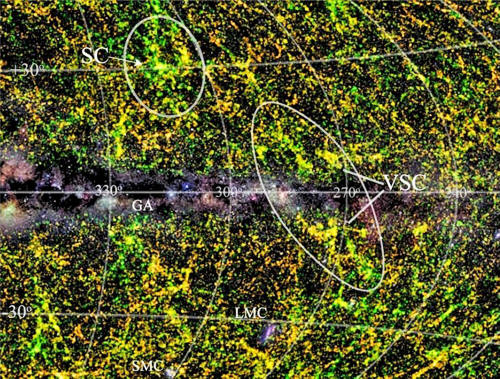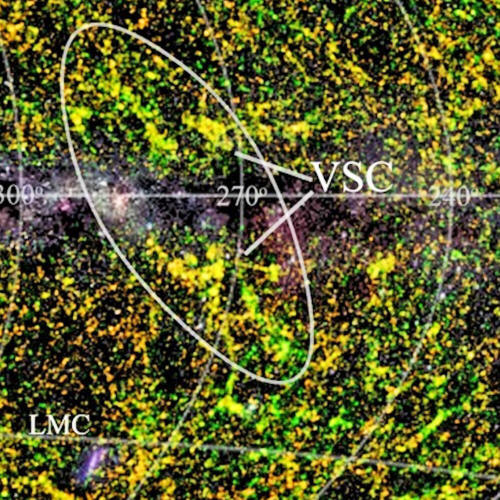|
November 24, 2016 from MessageToEagle Website
There is a path of the sky known as
'Zone of Avoidance' that has long been invisible to astronomers. It
is covered by the Milky Way, which obscures all structures behind it
The centre of the image, so-called the "Zone of Avoidance", is obscured by the Milky Way (with its stellar fields and dust layers shown in grey scale). Color indicates the distance ranges of all galaxies within 500-1000 million light years: (yellow is close to the peak of the Vela Supercluster (VSC) - larger ellipse; green is nearer and orange further away). The ellipse marks the approximate extent of the Vela Supercluster, crossing the Galactic Plane. Image credits: Thomas Jarrett (UCT)
Vela Supercluster, a gigantic group of galaxy clusters, hidden by the Milky Way galaxy's dust and stars, has now been revealed and astronomers report their discovery (Discovery of a Supercluster in the ZOA in Vela) in the Monthly Notices of the Royal Astronomical Society Letters.
It is believed to be the largest of its kind in our cosmic neighborhood.
Superclusters are considered most massive known structures in the universe.
Each one contains hundreds or thousands of galaxies. They can extend hundreds of millions of light-years end to end. The most famous, the Shapley Supercluster, for example, is thought to be the largest of its kind in our corner of the cosmos. It's around 650 million light-years away.
This supercluster was named after Harlow Shapley, an American astronomer, famous for his survey of galaxies, and one of the first scientists who believed in the existence of superclusters.
The Vela supercluster (VSC) had gone unnoticed due to its location behind the plane of the Milky Way, that hosts trillions of planets, more than 100 billion stars, and vast colorful clouds of gas and dust.
Renée Kraan-Korteweg and her crew examined thousands of galaxies partly within the Zone of Avoidance, which is partially masked by the Milky Way, with the Southern African Large Telescope in 2012.
They found eight new clusters in the area of the Vela constellation. Observations with the Anglo-Australian Telescope measured their redshift to track their movements - and it turned out they were all part of the one supercluster.
Further follow-up observations are needed to unveil the full extent, mass, and gravitational influence of the Vela Supercluster
|



